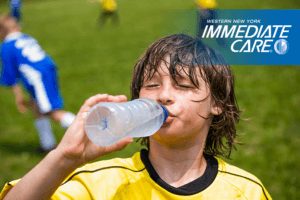
Lou Romig, MD
Heat and humidity are at their peak, leaving children vulnerable to heat-related illness. Extreme heat can cause children to become sick from dehydration, heat cramps, heat exhaustion and heat stroke. Here is what you need to know to protect your children from the potential health effects of extreme heat.
Heat exhaustion results from excessive loss of water and salt through sweat. Warning signs include: profuse perspiration; cold, clammy, pale skin; cramping; fatigue; weakness; headache; nausea; vomiting; dizziness; or fainting. Treatment includes:
Heat stroke is a potentially deadly condition in which the body’s thermostat malfunctions and body temperatures can reach 104 degrees or higher within 10-15 minutes. This is a very different problem than fever of 104 degrees because external factors are driving up the body temperature. Compounding the problem is the person is unable to perspire adequately so body heat is retained rather than released. Symptoms include: red, hot, dry skin; throbbing headache; nausea; dizziness; confusion; seizures; or even unconsciousness.
It is imperative to seek emergency medical assistance while cooling the person. Move the child to a cool place, remove clothing that might be trapping heat, and get cool water on the skin. DO NOT try to give anyone in this state something to drink; if they are delirious or confused, they might aspirate.